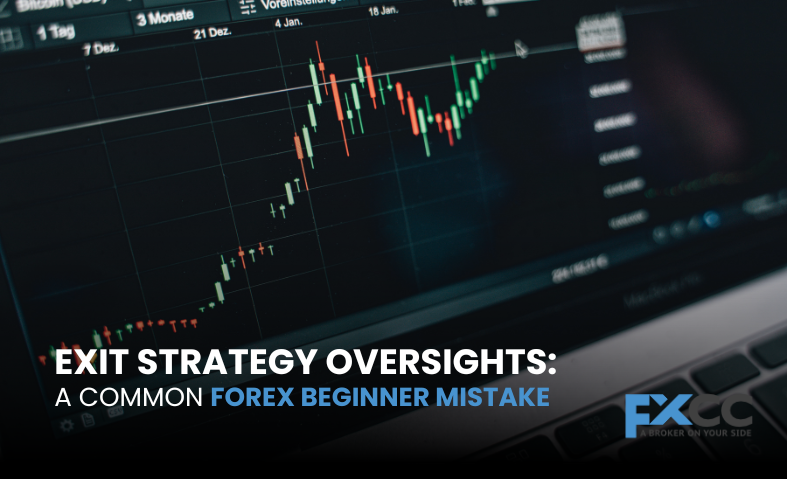Entering the Forex market is exciting but challenging. While beginners often focus on entry points and trends, many overlook the critical aspect of exit strategies. Knowing how to exit a trade effectively can determine success or failure. Let’s explore why exit strategies matter, common mistakes traders make, and how to create a solid plan for profitable trading.
Why an Exit Strategy Matters
An exit strategy is a roadmap for closing trades to secure profits or cut losses. Without a clear plan, emotions such as fear and greed can dominate, resulting in impulsive and often costly choices. For example, holding onto losing trades in the hope of recovery or exiting profitable trades too early can erode potential earnings. Forex markets are fast-paced and volatile, leaving no room for indecision. A well-defined exit strategy helps traders stay disciplined and manage risks effectively.

Common Mistakes in Exit Strategies
1. Trading Without a Plan
Beginners often focus on entering trades but neglect to plan their exits. This can lead to impulsive decisions, such as closing trades too early or holding onto losing positions for too long.
2. Ignoring Stop-Loss Orders
Stop-loss orders are essential for minimizing losses. By automatically closing a trade when losses hit a predefined level, they protect traders from significant damage. Ignoring this tool is one of the most costly mistakes beginners make.
3. Over-Reliance on Take-Profit Orders
While take-profit orders help secure gains, setting unrealistic targets or failing to adapt to market conditions can limit potential profits.
4. Emotional Trading
Emotions like fear and greed often lead traders astray. Fear can push traders to exit too early, while greed can make them hold onto trades longer than they should, resulting in missed opportunities or losses.
5. Failing to Adapt to Market Changes
Forex markets are influenced by news and global events. Sticking rigidly to a plan without considering market shifts can lead to unnecessary losses.
How to Build a Strong Exit Strategy
1. Set Clear Goals
Define your trading objectives before entering a position. Is your goal to capitalize on short-term opportunities or to build wealth over the long run? Your goal will shape your exit strategy.
2. Use Stop-Loss and Take-Profit Levels
A stop-loss order automatically closes a trade at a specific loss point, capping your risk. Typically, traders limit losses to 1-2% of their account per trade. Take-profit orders, on the other hand, lock in gains before the market reverses. Both tools work together to manage risk and secure profits.
3. Implement a Risk-Reward Ratio
A good risk-reward ratio ensures profitability even with a lower win rate. For example, a 1:2 ratio means you risk $1 to earn $2, making your trades more worthwhile.
4. Monitor Market Conditions
Stay informed about market news and events. Adjust your exit strategy if conditions shift unexpectedly. For instance, tighten your stop-loss or close a trade early during high volatility.
5. Stay Disciplined
Stick to your plan. Avoid emotional decisions and make adjustments only when justified by market trends or data. Discipline is key to long-term success.
Tips to Avoid Exit Strategy Mistakes
Start Small: Trade with small amounts to minimize risk while refining your strategy.
Practice in a Demo Account: Test your exit plans in a simulated environment to gain confidence.
Keep a Trading Journal: Record every trade, including entry and exit points, reasons for decisions, and outcomes. This helps identify patterns and improve future strategies.
Learn Continuously: Forex markets evolve constantly. Stay updated with new strategies and market insights to stay ahead.
The Role of Psychology
Trading psychology is vital in executing exit strategies. Fear and greed can cloud judgment, leading to poor decisions. For instance, fear might lead you to close a trade prematurely, while greed can tempt you to ignore your take-profit target in hopes of higher gains. Develop a disciplined mindset by focusing on your strategy rather than short-term emotions.

FAQs
1. What is a stop-loss order?
A stop-loss order automatically closes a trade when it hits a predefined loss level, helping minimize risk.
2. Why is take-profit important?
A take-profit order locks in gains at a set level, ensuring you secure profits before the market reverses.
3. What is a good risk-reward ratio?
A 1:2 ratio is ideal, meaning you risk $1 to earn $2. This ensures profitability even with a lower win rate.
4. How can a trading journal help?
A trading journal tracks your trades, helping you identify patterns, learn from mistakes, and refine your strategy.
5. Can you adjust your exit strategy mid-trade?
Yes, but adjustments should be based on market conditions, not emotions, to optimize outcomes.


